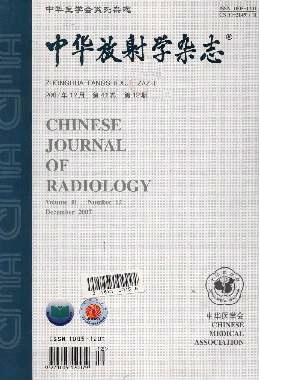A correlation study of CT and clinical features of different clinical types of COVID-19/ 新型冠状病毒肺炎不同临床分型间CT和临床表现的相关性研究
Q4 Medicine
Zhonghua fang she xue za zhi Chinese journal of radiology
Pub Date : 2020-04-10
DOI:10.3760/CMA.J.CN112149-20200205-00087
引用次数: 2
Abstract
Objective: To investigate the CT and clinical features of COVID-19. Methods: Chest CT and clinical data of 103 patients who were confirmed as COVID-19 in January 2020 were collected retrospectively. According to diagnosis and treatment of COVID-19 (trial version 5), all the patients were classified into common(n=58), severe (n=36) and critical (n=9) types, and their clinical findings, laboratory examination and CT finding were analyzed. CT features included distribution, location, size, shape, edge, number and density of the lesion, percentage of pneumonia lesions of the whole lung and extra-pulmonary manifestations. The CT features among different clinical types were compared using χ 2test or Fisher's exact probability. Comparisons of age, duration from onset to CT examination, and percentage of pneumonic lesions to total lung volume among different types were performed by using analysis of variance (normal distribution) or Kruskal-Wallis rank sum test (non-normal distribution). Results: In terms of clinical manifestations, the patients with critical COVID-19 were more common in elderly men, with a median age of 65 years. Fever was the first symptom in 49 (84%) of 58 common patients, and also the first symptom in both severe and critical COVID-19 patients. The incidence of coughing in severe (25/36, 69%) and critical (6/9, 67%) COVID-19 patients was higher than that in common patients (20/58, 34%). All critical patients had dyspnea. CT showed the common COVID-19 was located in bilateral lung (40/58, 71%)with multiple (40/58, 69%), ground glass (31/58, 52%) or mixed (25/58, 43%)opacities (56/58, 97%), while all the severe and critical COVID-19 were located in bilateral lung(100%) with multiple (34/36, 96%), patchy (33 /36, 92%), or mixed opacities (26/36, 72%) in severe patients, and with mixed opacities more than 3 cm in critical patients. As for the percentage of pneumonia focus in the whole lung volume, the common type (12.5%±6.1%) was significantly lower than the severe type (25.9%± 10.7%) and the critical type (47.2%±19.2%), with statistically significant differences(P< 0.001 and 0.002 respectively), and the severe type COVID-19 was also significantly lower than the critical type (P= 0.032). Conclusions: CT and clinical features of different clinical types of COVID-19 pneumonia are different. Chest CT findings are characteristic, which can not only help the early diagnosis but also evaluate the clinical course and severity.A correlation study of CT and clinical features of different clinical types of COVID-19/ 新型冠状病毒肺炎不同临床分型间CT和临床表现的相关性研究
目的:探讨新冠肺炎的CT及临床特点。方法:回顾性收集2020年1月确诊的103例新冠肺炎患者的胸部CT及临床资料。根据新冠肺炎(试验版5)的诊疗情况,将所有患者分为普通型(58例)、重症型(36例)和危重型(9例),并对其临床表现、实验室检查和CT表现进行分析。CT表现包括病灶的分布、位置、大小、形状、边缘、数量、密度、全肺肺炎病变占比及肺外表现。采用χ 2检验或Fisher精确概率比较不同临床类型的CT表现。采用方差分析(正态分布)或Kruskal-Wallis秩和检验(非正态分布)比较不同类型患者的年龄、发病至CT检查时间、肺病变占肺总容积的百分比。结果:从临床表现来看,危重型新冠肺炎患者以老年男性多见,中位年龄65岁。58例普通患者中有49例(84%)以发热为首发症状,重症和危重型患者均以发热为首发症状。重症(25/36,69%)和危重(6/9,67%)患者咳嗽发生率高于普通(20/58,34%)患者。危重患者均有呼吸困难。CT显示常见的新型冠状病毒肺炎位于双侧肺(40/ 58,71%),伴多发(40/ 58,69%)、磨玻璃(31/ 58,52%)或混合性(25/ 58,43%)混浊(56/ 58,97%),重型和危重型均位于双侧肺(100%),伴多发(34/ 36,96%)、斑片状(33 / 36,92%)或混合性(26/ 36,72%)混浊,危重型伴混合性混浊大于3cm。肺炎病灶占全肺容积的比例,普通型(12.5%±6.1%)显著低于重症型(25.9%±10.7%)和危重型(47.2%±19.2%),差异均有统计学意义(P分别< 0.001和0.002),重症型也显著低于危重型(P= 0.032)。结论:不同临床类型COVID-19肺炎的CT及临床表现不同。胸部CT表现具有特征性,不仅可以帮助早期诊断,而且可以评估临床病程和严重程度。
本文章由计算机程序翻译,如有差异,请以英文原文为准。
求助全文
约1分钟内获得全文
求助全文
来源期刊

Zhonghua fang she xue za zhi Chinese journal of radiology
Medicine-Radiology, Nuclear Medicine and Imaging
CiteScore
0.30
自引率
0.00%
发文量
10639
 求助内容:
求助内容: 应助结果提醒方式:
应助结果提醒方式:


